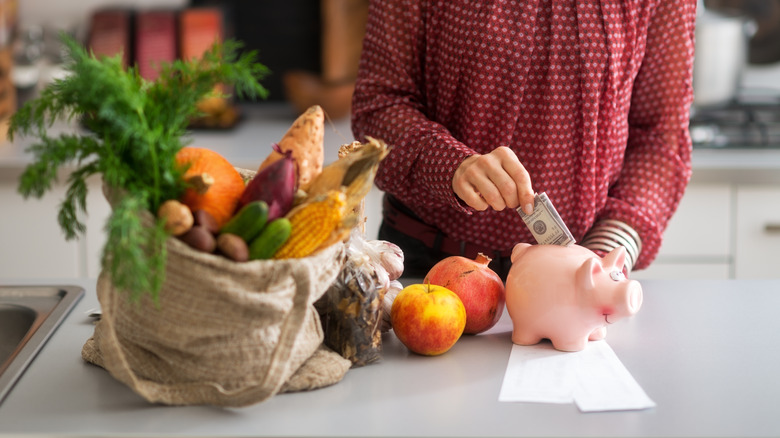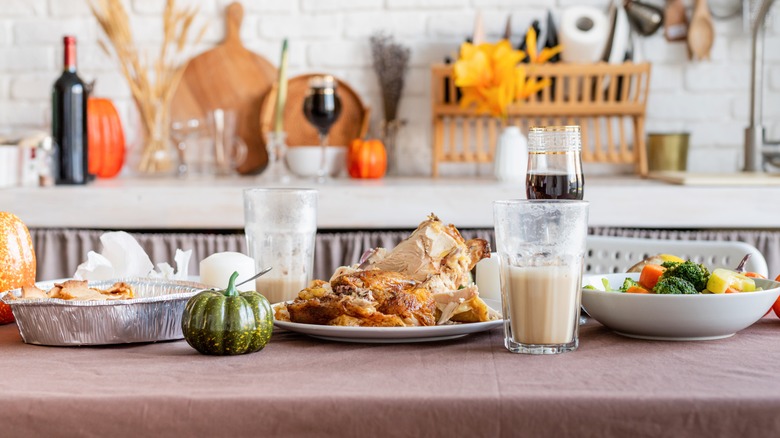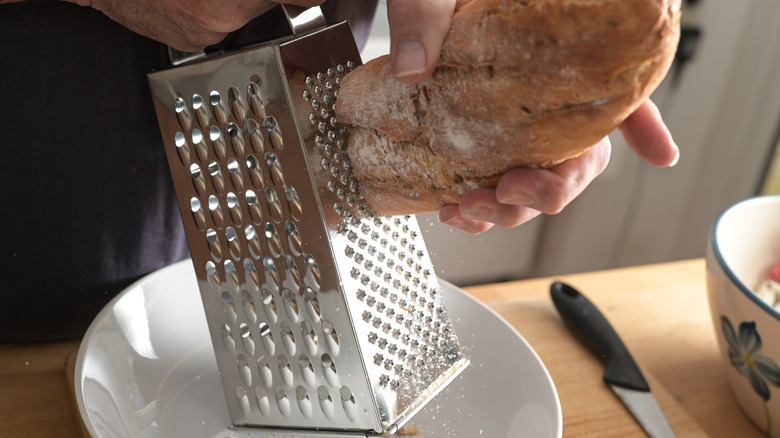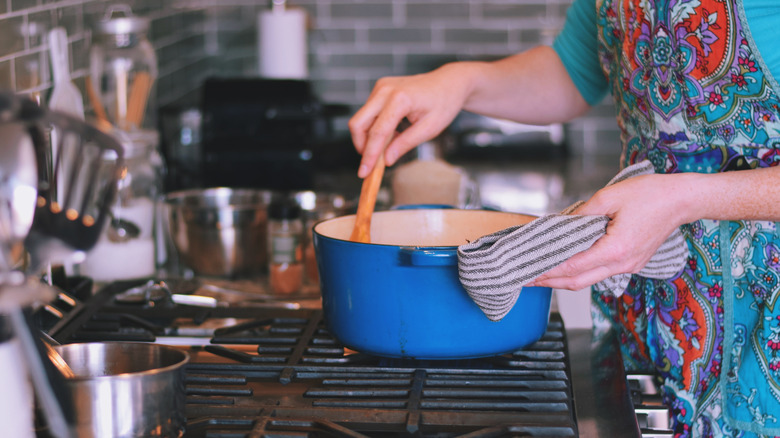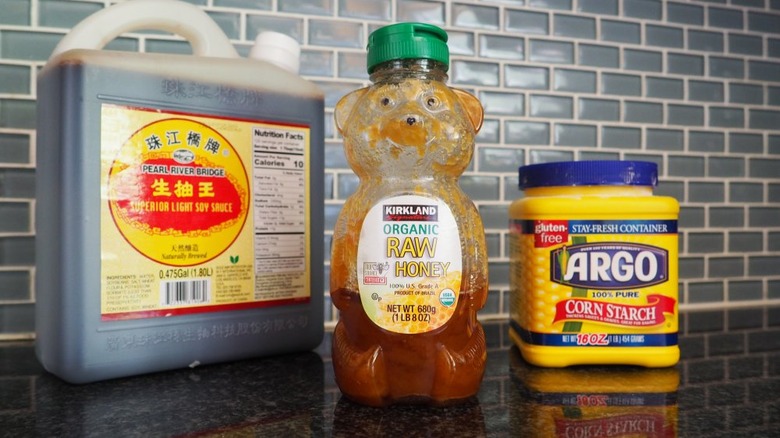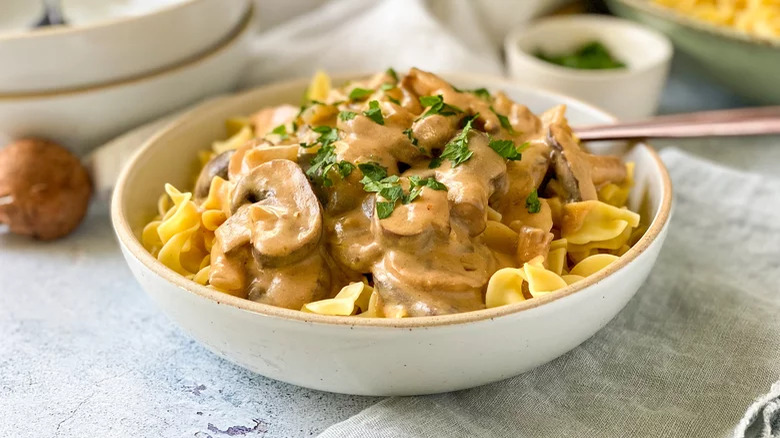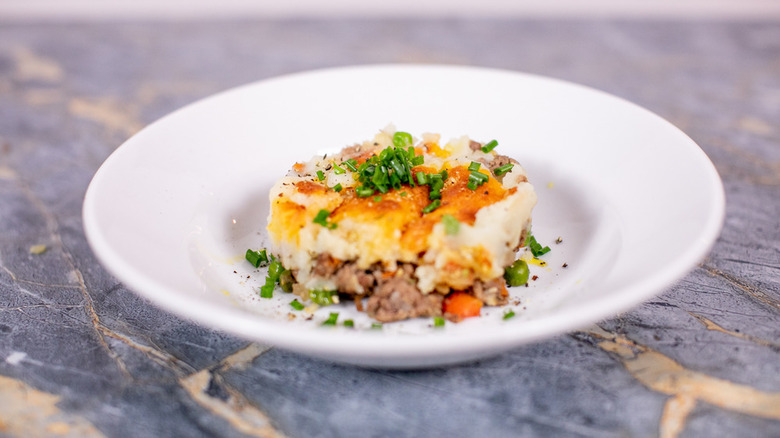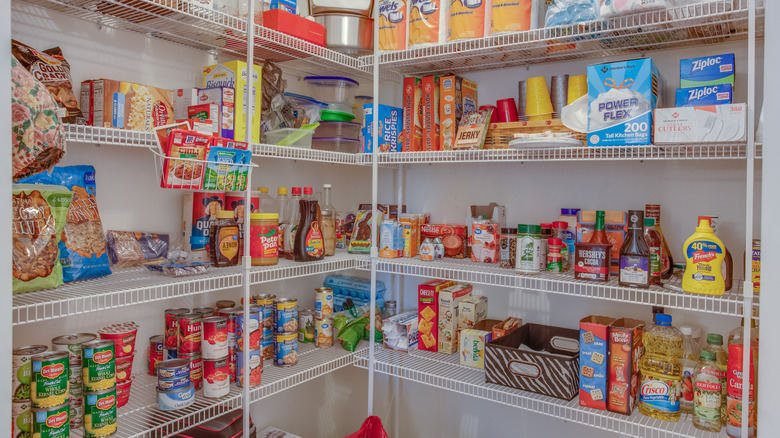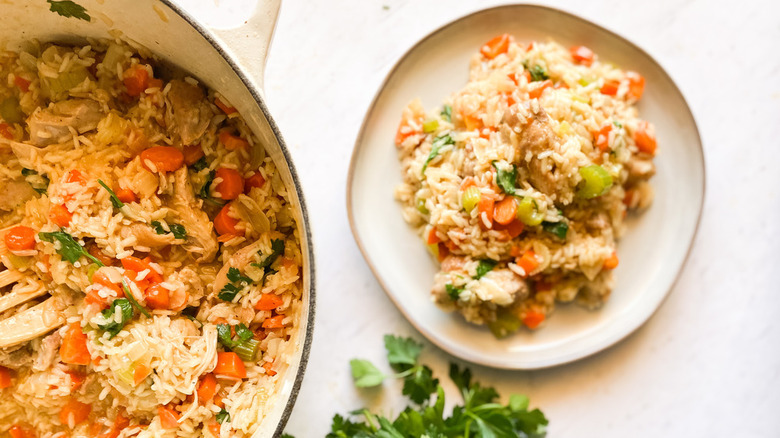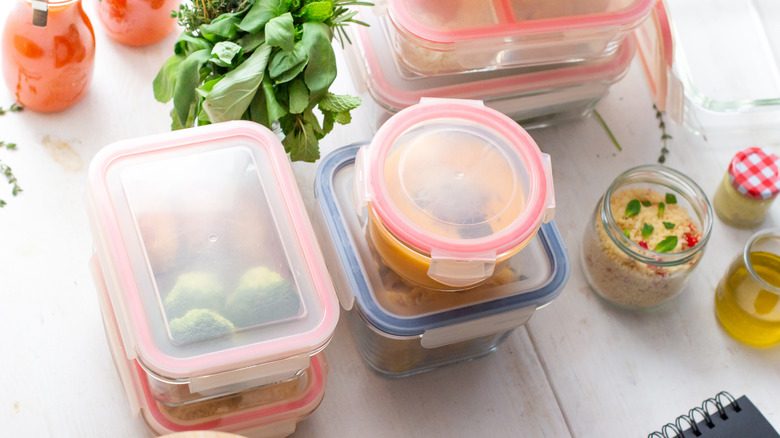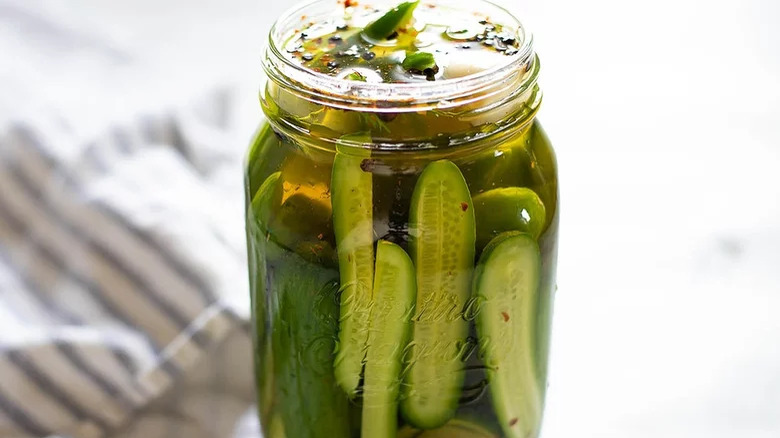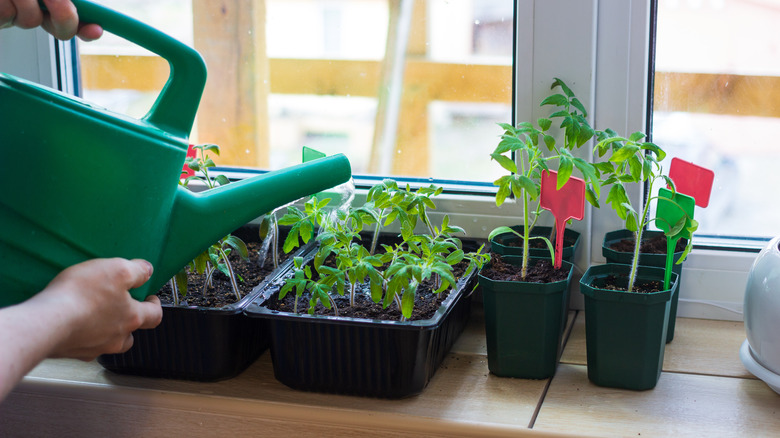14 Retro Hacks To Cut Down On Food Costs
Food bills are rising in the U.S. with an 11.4% hike in 2022 compared to the previous year, according to the U.S. Department of Agriculture (USDA). And it's not looking likely that your grocery shop is going to get much cheaper anytime soon. While you might see this as a sign to tighten consumption, it's also a motivation to look for money-saving ideas that don't compromise your enjoyment of food. You could start by checking out cheap and easy recipes the whole family will love, as everyone could use solid weekday meals that are within budget.
Tips from the past are also useful for inspiring frugality today when preparing home-cooked meals. Classic recipes that make ingredients stretch further or simply use less expensive elements are a great way to reduce what you spend. They can also lead you to discover traditional dishes such as Toad in the Hole. Here are 14 retro hacks to cut down on food costs.
1. Use more affordable chicken cuts
Just as you're not going to use the most expensive prime rib to make a simple chili, you can also use more affordable pieces of chicken in plenty of dishes. It's true that chicken breast is lean, nutritious, and fantastic in a stir-fry. However, if you're feeding a family you're not going to find it goes as far as other cuts for the same price. If you're balking at the idea of compromise, don't. Using cheaper cuts doesn't mean cutting down on taste.
Certain recipes taste better with chicken cooked on the bone or with darker meat, especially if you're stewing it in a casserole or a one-pot dish. When people used to shop more regularly at the butcher, it was natural to buy a whole chicken and use every part of it. Try our skillet mushroom chicken recipe with boneless or bone-in chicken thighs. The chicken is succulent and terrifically tender when cooked in a skillet on the stove. Lemon herb chicken quarters are exceptionally juicy too, and the recipe is super easy to make since you simply roast the dark meat. The herbs and citrus flavors do wonders to complement this budget-friendly poultry meal.
2. Make meals from leftovers
In today's throwaway world, it's commonplace to finish a meal and dump leftovers in the waste disposal. You're not going to want to save some mashed-up remnants of food off someone's plate. However, it can be tricky to weigh up exactly how much food you need when cooking for a crowd. You might feel stuffed after a special family feast, but chances are there's plenty more of everything still remaining. If you're making lots of dishes and everyone's helping themselves, then whatever hasn't been touched is potentially another recipe-in-waiting. You don't have to eat the same meal twice either. Cooking with leftovers is all about culinary creativity.
Make a Thanksgiving leftover pizza the next time the holiday comes around, with turkey, stuffing, mashed potato, gravy, and cranberry sauce. Even with regular meals, it's not easy to judge how much is needed, especially if you're making a big pot of creamy mashed potatoes. With some bacon lardons, green onions, and cheese you can create potato cakes — a comfort food classic that's perfect for brunch, lunch, or supper. Meanwhile, by turning leftover rice into rice pudding, you've created a sweet dessert from a savory side dish. Or, shape leftover rice into balls for delicious arancini or turn on the stove for quick fried rice. You could also combine leftover carbs and proteins into a patty of your choosing.
3. Don't waste scraps
Scraps lurking in the fridge or bread box are often ignored to the point that they're no longer fit for human consumption. It's true that a dry heel of bread or half a carrot that's past its best doesn't exactly inspire. However, these scraps can be turned into tasty dishes without needing to bring a huge amount of imagination to the table. Can you imagine budget-conscious home cooks of yesteryear throwing away the end of an onion or a bit of broccoli that wasn't enough to serve as a whole side? Absolutely not. Cut down on food costs by using scraps.
You could try making a pie with everything that needs to be used up at the end of the week. Or, gather vegetables that could go to waste and make a flavorful soup. Then, use the peelings to make vegetable chips. If you need to use up egg whites, add them to meatloaf or make a meringue.
As for stale bread, turn it into breadcrumbs by baking torn-up pieces in the oven and breaking them up with a food processor. You can also grate toasted or frozen bread for less cleanup. Then, add some dried herbs and mix the crumbs with ground beef to create Italian meatballs. Alternatively, sprinkle breadcrumbs on a casserole or macaroni and cheese for a crunchy topping. If you've got a whole loaf that's past its peak freshness, try making bread pudding.
4. Bake eggless recipes
In March 2023, CNBC reported that egg prices in the U.S. had risen by 70% in the past year. Recently, a Manhattan grocery store was reportedly selling organic eggs for up to $18 for a dozen (via The Guardian). Whereas you might have regarded eggs as a budget staple in the past, now you might think twice before adding a couple to a recipe. Once upon a time, egg rations weren't always so plentiful either. It was during these moments of scarcity that home cooks came up with novel ways to adapt recipes. Cutting down on eggs could cut down on your food costs, but that doesn't mean you can't enjoy traditional dishes that are usually made with eggs.
Try our savory eggless crepes made with butter, milk, and flour with thin slices of Brie to make them creamy and luxurious. It might come as a surprise but you can also make French toast, also known as eggy bread, without eggs. Instead, the bread coating is made with milk and cornstarch as a binder, and vanilla extract and cinnamon to create the classic taste. Enjoy a retro flavor that's never gone out of fashion with some syrup drizzled on top.
5. Cook one-pot dishes
If you're cooking different dishes at the same time, then you're likely firing on all cylinders when it comes to energy usage, as well as ingredient cost. Instead, try some budget-conscious one-pot recipes. Not only do they make culinary life easier, but there's a lot more leeway to add whatever produce you've got on hand.
You can also cook up a big pot of meat or a base sauce at the same time. Then, use them to create a variety of dishes for the rest of the week. Cooked ground beef along with tomato sauce, for example, can be turned into pies, pasta dishes, and casseroles. You can make a delicious meal on the stove or in the oven, or pull out your slow cooker, pressure cooker, or air fryer.
If you're hosting a party or feeding an extended family during the holidays, being able to rustle up a one-pot wonder could save you money. A big pot of chili is delicious and way more cost-effective than trying to create individual dishes for a crowd. For a family, you can also make enough food in one pot to cover supper for the night.
6. Follow recipes with fewer ingredients
There's nothing more wonderful — for foodies — than a homecooked meal. It's also way more affordable than eating out ... most of the time. However, an elaborate recipe with pricey ingredients can turn a kitchen creation into a meal that's more expensive than dining at your local eatery. It also doesn't make budget sense if you're buying ingredients that you're not going to use again anytime soon.
You might decide it's worth it to swap out high-end ingredients such as saffron or simply leave them out altogether. Choosing budget-style recipes is also a good idea, so you may want to leave irresistible truffle dishes for when you're cooking for a special occasion. If you think about it logically, the cost of making a complex curry with a myriad of spices could start getting pricey if you don't already have them on hand.
Instead, find pleasure in simple recipes composed of a few ingredients that are still full of flavor. Our 3-ingredient pumpkin hummus upgrades the store-bought stuff with pumpkin pie spice and pumpkin puree. If you love Asian flavors, then try our 3-ingredient stir-fry sauce by whisking soy sauce, honey, and cornstarch together. Use it to enhance some food scraps before throwing it all in your wok with budget-friendly noodles.
7. Use other ingredients in place of meat
Many people have gotten used to eating a lot more meat than is recommended. And while some cuts of meat are less expensive than others, cutting down on meat in homecooked dishes may mean both a healthier body and food bill. There are some incredible vegetarian and vegan recipes to explore, with plant-based eating an ever-evolving trend. Even committed carnivores can benefit from a tasty meat-free meal.
However, if you don't like the idea of forgoing your favorite meaty dishes, then switch them up by using other ingredients in place of meat. If you love a traditional sloppy joe then try our vegan version made with lentils and a spiced tomato sauce. You might crave stroganoff for date night or a special meal, but it's classically made with filet steak, making it a luxury dish. Mushroom stroganoff served with velvety wide noodles is just as moreish with a creamy white wine sauce. Of course, you'll want to use a budget wine or make sure it pairs with the meal at least. Beans are a cheap meat substitute and tofu is another great source of protein. Still, if you don't want to miss out on meat entirely, simply reduce the amount and add more vegetables instead.
8. Cook with offcuts
Do you always cook with the same cuts of meat and fish? A fantastic retro hack to reduce food costs is to use offcuts to make a meal. They can be just as nutritious and are super tasty if you cook them in the right recipe. You might love a fillet of pan-fried fish, but what about making a dish from fish heads? In Asian cuisine, you'll find fish heads used in plenty of dishes, and a number of European countries use them in recipes too. A popular soup in Thailand is made with a whole fish including the top and tail, seasoned with spices and lemongrass. In England, a stargazy pie is an old-fashioned dish with pilchard heads sticking out of the pastry.
Choose less common cheaper cuts of meat such as lamb necks and oxtail for your next family meal. Understanding how to season, marinade, and cook meat that's not a simple steak really comes into play here. You could also shop for offcuts from your butcher and use them in suitable recipes such as a stew. There are so many dishes that can be made with bits of meat that are not the standard cuts and joints you usually buy.
9. Use mashed potato
You don't have to wait until you've got leftover mashed potatoes to use them as an ingredient to create another dish. So many dishes shine with the addition of potato and cost less because it is an affordable starch. Make our classic shepherd's pie recipe with a mashed potato topping browned in the oven and a rich mix of ground meat with peas and carrots. A fish pie is also perfect with a mashed potato topping to finish it off.
Of course, mash is a filling side as well. But to make more of a meal out of it, add delicious ingredients such as bacon, cheese, sour cream, and spring onions. Our Instant Pot loaded mashed potatoes are the ultimate comfort food. What's great about this idea is that you can throw in whatever you want and customize the dish. To make life easier you can also microwave pierced potatoes until they're ready to mash and forgo the stove. Mashed potato with gravy is a perfect pairing, and who doesn't love melted cheese with a creamy mash? Take boiled potatoes one step further by blending them with broth and milk for a hearty potato soup that makes use of inexpensive ingredients.
10. Make pantry meals
Take a look in your larder and pantry cupboards. If they're well-stocked then you no doubt have plenty of cans of soup, vegetables, and other produce. You may have some tinned fish like sardines, salmon, and mackerel too. What about dried herbs and spices? Do you have a stash of bouillon cubes? How about flour, couscous, and pasta? Many households have cartons of long-life milk, passata, and tomato puree. Did you stock up on jars of pickles, olives, sundried tomatoes, artichokes, and peppers? Anybody would think you had enough for an endless array of recipes. That's because you do.
Reduce your food bill for fresh and frozen produce and plunder your stores instead. As well as being a budget-friendly approach, it's also a good idea to get through these dry goods rather than keep stockpiling them. You can mix and match pantry items with fresh ones, such as with our easy salmon patty recipe which uses a can of salmon as the star ingredient. Meanwhile, a packet of cooked rice, a can of vegetables, such as sweetcorn, and a tin of tuna equals a thrifty and tasty meal.
11. Bulk up proteins with rice
A balanced diet contains proteins, carbs, and fats. With such a big focus on meat in the modern world, there's an imbalance in what a lot of people eat. A great retro tip is to turn less protein into more servings by bulking it up with rice. It's not just about reducing your grocery bill either. Adding rice to a meat dish with sauce really brings the ingredients together and can enhance the consistency. Otherwise, you might just be eating gravy with bits of meat sinking in it.
Make a one-pot chicken and rice and score retro hack points for using chicken thighs rather than breasts and cooking everything in a Dutch oven. Imagine this dish without the rice — it just doesn't sound as comforting. Meanwhile, our Instant Pot dirty rice recipe puts the grain front and center, combining it with sausage, chicken livers, bell peppers, as well as plenty of herbs and spices. Budget-friendly porcupine meatballs made from rice and ground beef in tomato sauce are a popular favorite from the Great Depression. Why not enjoy them now?
12. Batch cook your meals
Before the age of takeout, convenience food from stores, and a myriad of ingredients and gadgets to make cooking easier, people ate what they cooked. There was less eating out and grabbing food on the go, and food delivery wasn't an option. When fresh meals need to be prepared all the time, savvy tips make cooking easier and keep costs down. A smart idea if you want to focus on making more food at home is to get your batch cooking mojo on.
If you've never batch cooked before, prepare to really enjoy it. There's something meditative about spending an evening or a weekend day prepping different sauces and dishes for the fridge and freezer. Turn up the sound, pour a glass of vino, and enjoy the relaxation that cooking without pressure brings. You can plan your menu, buy more for less, and you're less likely to let food go to waste. By creating your own ready-made meals you're going to be less inclined to fritter money away on high-priced dishes when you're hungry. Not to mention, you get to control your diet more effectively.
13. Preserve foods
From drying and pickling to canning and fermenting, it was once common practice to both eat foods in season when they're in abundance and also to preserve them. This can really cut down on food costs. Even creating a root cellar area pays off since potatoes, carrots, and onions will last much longer if they're in a dark space that's nice and dry. Try drying fruits like cherries in the oven or fermenting cabbage with salt. Pickling is easy as long as you properly sterilize your jars, and canning just requires a specific type of jar.
Don't be put off by the idea of preserving food because you think it's complex or that you need to have huge quantities to store. Our homemade refrigerator pickles are super simple and just call for the right ratio of white vinegar, water, and sugar. They only last two weeks in the fridge so you won't end up overstocked with too many jars either.
14. Grow your own veggies and herbs
Consider growing your own windowsill veggies and herbs to make dishes with homegrown produce. Fresh herbs can be pricey and they often wilt before you've had time to use them all. If you create a kitchen garden on your sill, you don't even need a lot of space. Not having a big outdoor area isn't an excuse not to go back to nature and connect with the food you eat.
A number of vegetables are relatively easy to grow and don't need a lot of attention or a big area if they grow upward. You can grow tomato plants in a homemade planter made from a soda bottle, and you can use the ends of scallions to regrow green onions. This retro hack to cut down on food costs is also an old-fashioned way to be mindful about what you eat — and with that, perhaps less frivolous.
